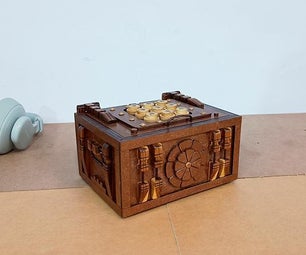Introduction: Crayon Lathe LittleBits
This is quite possibly the smallest and safest lathe in the world! And its a lot of fun to use. It will turn crayons or oil pastels.
I have included a template for wood and a .STL model for 3D printing. But there are many materials the body could be made of Lego, plastic, steel...what else can you think of?
Materials
Tools (Wood construction)
I have included a template for wood and a .STL model for 3D printing. But there are many materials the body could be made of Lego, plastic, steel...what else can you think of?
Materials
- LittleBits DC motor
- LittleBits Power Supply
- 9Volt battery
- plywood for the body
- wood for the tailstock
- a 4-5 cm screw
Tools (Wood construction)
- Wood saw
- center punch (a nail or screw works)
- hammer
- tape
- paper template
- scissors
Step 1: Step 1 Making the Lathe Body
Wood
1) Print out the pdf template 1:1 scale (100%). (117-LatheBaseWood.pdf)
2) Double check that it printed to 1:1 scale by measuring the width. It should be 100mm wide.
3) If its good cut it out.
3D Printing
1)Download the STL model from Thingiverse. Print it. http://www.thingiverse.com/thing:229607
2)Next drill out the 6 LittleBits mount holes to 6mm.
3)Then drill out the tailstock hole to slightly smaller than your screw diameter.
Attachments
Step 2: Step 2 Place the Template on Your Wood.
1)Tape the template down so it doesn't move and trace around the edges.
2)Use a screw and hammer to center punch the holes as close as possible!
3)Center punch the tailstock corners too because we will use those marks to glue the tailstock block to later (see pic)
4)Remove the template and cut out the lathe body with a saw.
2)Use a screw and hammer to center punch the holes as close as possible!
3)Center punch the tailstock corners too because we will use those marks to glue the tailstock block to later (see pic)
4)Remove the template and cut out the lathe body with a saw.
Step 3: Step 3: Cut Out the Tailstock Block
The block should be 20 x 20 x and at least 16mm tall so the tailstock screw can be drilled into it at 9mm from the base.
Step 4: Step 4 Drill the Holes
1) Drill the LittleBits mounting holes in the body to 6mm.
2)Drill the hole in the tailstock block. 9mm above the bottom of the block. It should be a little smaller than the outside diameter of the screw you use.
3) Test fit the screw in the tailstock hole. Use a screwdriver or a power drill to thread the screw in and out a fe times until you can thread it in and out with your fingers easily.
2)Drill the hole in the tailstock block. 9mm above the bottom of the block. It should be a little smaller than the outside diameter of the screw you use.
3) Test fit the screw in the tailstock hole. Use a screwdriver or a power drill to thread the screw in and out a fe times until you can thread it in and out with your fingers easily.
Step 5: Step 5 Assembly and Glue
1)Gently press the LittleBits DC Motor and Power supply into the mounting holes. If the holes are drilled correctly, they should press fit in with just a little pressure.
2) Glue the tailstock block in place. Use a ruler to make sure the motor and the screw ae in a straight line.
Ok done!
Here is the How To Video.
Tip!
When loading the crayon or pastel into the Little Bits coupler, shave the tip of the crayon into a square so it locks into the coupler. This helps prevent slipage.
2) Glue the tailstock block in place. Use a ruler to make sure the motor and the screw ae in a straight line.
Ok done!
Here is the How To Video.
Tip!
When loading the crayon or pastel into the Little Bits coupler, shave the tip of the crayon into a square so it locks into the coupler. This helps prevent slipage.

Grand Prize in the
Supercharged Contest












